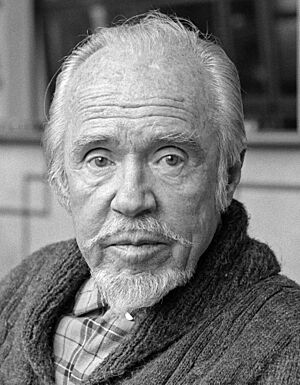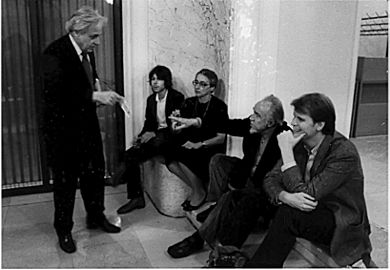Conlon Nancarrow facts for kids
Quick facts for kids
Conlon Nancarrow
|
|
|---|---|

Nancarrow in 1987
|
|
| Born |
Samuel Conlon Nancarrow
October 27, 1912 |
| Died | August 10, 1997 (aged 84) Mexico City, Mexico
|
| Nationality | Mexican, American |
| Occupation | Composer |
| Known for | Studies for Player Piano |
Samuel Conlon Nancarrow (October 27, 1912 – August 10, 1997) was an American-Mexican composer. He lived and worked in Mexico for most of his life. Nancarrow is best known for his Studies for Player Piano. He was one of the first composers to use instruments that play by themselves. He saw that these instruments could play music much faster and more complex than people could. He lived quietly for many years and became widely known in the 1980s.
Contents
Conlon Nancarrow's Life Story
Early Years and Moving to Mexico
Conlon Nancarrow was born in Texarkana, Arkansas. When he was young, he played the trumpet in a jazz band. He later studied music in Cincinnati, Ohio, and Boston, Massachusetts. His teachers included Roger Sessions and Walter Piston.
In Boston, Nancarrow joined a political group. When the Spanish Civil War started, he went to Spain. He joined a group called the Abraham Lincoln Brigade. They fought against Francisco Franco's forces. In 1939, he was held in a camp in France. When he returned to the United States, he found it hard to get his passport renewed. To avoid problems, Nancarrow moved to Mexico in 1940.
He visited the United States briefly in 1947. In 1956, he became a Mexican citizen. He didn't return to the U.S. until 1981 for a music festival. He lived in Mexico City until he passed away at age 84. He was friends with some Mexican composers. However, he was mostly unknown in the local music world.
Becoming a Unique Composer
It was in Mexico that Nancarrow created his most famous works. He had written some music in the U.S. But his pieces were so hard that human musicians found them almost impossible to play well. This problem continued in Mexico. Since there were few musicians who could play his difficult music, he needed a different solution.
Nancarrow found his answer in the player piano. This idea came from a book by Henry Cowell called New Musical Resources. A player piano can play by itself using special paper rolls. This allowed Nancarrow to create incredibly complex rhythms and speeds. These were far beyond what human hands could manage.
Nancarrow wanted to explore how different speeds could work together in music. He started making pieces where different parts played at their own speeds. Sometimes, these speeds would even change within the music. He later said that player piano rolls gave him more control over time in his music than early electronic music could.
In 1947, Nancarrow went to New York City. He bought a special machine to punch holes in the piano rolls. This machine was adapted from ones used in factories. It was very slow and hard work to use. He also changed his player pianos. He made them louder by changing their parts. He covered the hammers with leather or metal. This gave the pianos a more percussive sound.
Nancarrow's early pieces mixed the sounds of early jazz pianists like Art Tatum. He combined these with very complicated rhythm patterns. His first five rolls were called the Boogie-Woogie Suite. Later, he wrote more abstract music. These pieces didn't sound like any other music except his own.
Many of his later pieces were called studies. They often used a technique called canon. This is where a melody is played by different parts, but at different speeds. For example, in Study No. 40, the parts play at speeds based on e and pi. Study No. 37 has twelve different melodies, each moving at a different speed!
For many years, Nancarrow was not well-known. But in 1969, a record company released an album of his work. This helped him start to gain attention.

Later Life and Recognition
In the late 1970s, people like Peter Garland and Charles Amirkhanian helped Nancarrow's music become more widely known. Recordings of his player piano works were released. So, at age 65, Nancarrow started to get public attention.
In the 1980s, he became very famous. Many important composers, like György Ligeti, called him one of the most important composers of his time. In 1982, he received a special award called a MacArthur Fellowship. This award gave him a lot of money over five years. This new interest in his work led him to write music for regular instruments again. He composed several pieces for small groups of musicians.
Conlon Nancarrow passed away in 1997 in Mexico City. All the items from his studio, including his player piano rolls and instruments, are now kept at the Paul Sacher Foundation in Switzerland.
Conlon Nancarrow's Musical Legacy
In 1995, a book about Nancarrow's music was published by Kyle Gann. This book helped people understand his unique style.
Today, some of Nancarrow's player piano studies have been changed. Musicians can now play them on other instruments. German musicians like Wolfgang Heisig have performed Nancarrow's original rolls live. They use instruments similar to Nancarrow's own.
Other groups, like Alarm Will Sound and Calefax, also perform his works. American clarinet player and composer Evan Ziporyn has adapted Nancarrow's studies for the Bang on a Can All-Stars.
Nancarrow's work is also seen as an early version of Black MIDI. This is a type of electronic music with many notes played at once.
In 2012, a festival was held in California to celebrate 100 years since Nancarrow's birth. In 2024, composer Dario Acuña Fuentes-Berain created a new work. He performed it on Nancarrow's historic piano in his Mexico City studio.
Recordings of Nancarrow's Music
Many of Conlon Nancarrow's works have been recorded. These recordings help people around the world hear his amazing music.
- Early Recordings: Columbia Records released an album of his studies in 1969. New World Records also released recordings in 1976.
- Original Instruments: Between 1977 and 1984, 1750 Arch Records released recordings. These were special because they used Nancarrow's own player pianos. This means they sound exactly as he heard them in his studio.
- Complete Works: The German Wergo label released all of Nancarrow's player piano music between 1989 and 1991.
- Other Recordings: In 1993, BMG released a CD of his works played by the Ensemble Modern. In 2000, Other Minds Records released a CD called Lost Works, Last Works. This included pieces that had not been recorded before. In 2008, Other Minds Records re-released the 1750 Arch Records recordings.
List of Conlon Nancarrow's Works
Here are some of the musical pieces Conlon Nancarrow created:
Player Piano Music
- Studies #1–30 (1948–1960)
- Studies #31–37, #40–51 (1965–1992)
- For Yoko (1990)
- Contraption #1 for computer-driven prepared piano (1993)
Piano Music
- Blues (1935)
- Prelude (1935)
- Sonatina (1941)
- 3 Two-Part Studies (1940s)
- Tango? (1983)
- 3 Canons for Ursula (1989)
Chamber Music (for small groups)
- Sarabande and Scherzo for oboe, bassoon and piano (1930)
- Toccata for violin and piano (1935)
- Septet (1940)
- Trio for clarinet, bassoon and piano, #1 (1942)
- String Quartet #1 (1945)
- String Quartet #2 (late 1940s) (incomplete)
- String Quartet #3 (1987)
- Trio for oboe, bassoon and piano, #2 (1991)
- Player Piano Study #34 arranged for string trio
Orchestral Music
- Piece #1 for small orchestra (1943)
- Piece #2 for small orchestra (1985)
- Studio for Orchestra, canon 4:5:6 (1990–91) (Based on Study 49 a-c)
See also
 In Spanish: Conlon Nancarrow para niños
In Spanish: Conlon Nancarrow para niños

